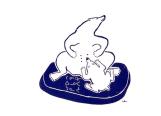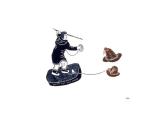1
Daniel Inukpuk2009
Inukjuak Co-operative, Inukjuak, Quebec, Canada
 Credits:
Credits:Photo: Inuit Art Foundation
2
Daniel Inukpuk [b. 1942]"I think carving is an important part of our culture, but the generation today have more interests other than carving, so it seems inevitable that we will start to lose that part of our culture" (2009)
His story
Daniel Inukpuk, son of Johnny Inukpuk, was born in 1942, in Sarollie Weetaluktuk's camp near Inukjuak. He started carving around 1960. His sculpture was first exhibited in Eskimo Sculpture, a show organized by the Winnipeg Art Gallery in 1967. In the early 1970s, Inukpuk contributed to several Nunavik print collections, having learned printmaking from Thomassie and Lucassie Echalook. Inukpuk split his time evenly between printmaking and carving until the Inukjuak print shop closed around 1976. In addition to dozens of North American cities, Inukpuk's work has been shown in France, Belgium, Italy, Israel, and Japan. Many public institutions have his work in their collections. Inukpuk remains an active carver, although, in an interview with staff of the Inuit Art Foundation in 1998, he said carvers face different obstacles than they did when he first started and "it is more difficult these days to be a carver... When we first started carving, there was lots of stone, but these days, it's difficult to find... We have to go a very long distance for stone, quite a ways from Inukjuak. We have to dig quite deep to get the kind of stone that quallunaq like" (Inuit Art Quarterly [IAQ] 1998:42).
A board member of the Unaaq's Men's Association, which was founded in Inukjuak in 2001, Inukpuk has organized a series of workshops for younger males so that they can learn to make fish-nets, igloos, kayaks, and traditional tools.
His art
Referring to his prints in 1976, Virginia Watt, director of the Canadian Guild of Crafts Quebec, wrote: "Daniel Inukpuk is a man of action. His prints have a sense of immediacy. None of his figures are at rest. His images run, fight, fly, play, swim, and hunt with enormous energy. His prints show a concern with, and a mastery of form which fully equals his interest in his subject matter" (1976:5). Although Inukpuk favours hunting scenes, he stopped carving them after Greenpeace mounted its highly publicized campaign against the killing of seals.
In the interview with Inuit Art Foundation staff in 1998, Inukpuk said he felt his community is more arts-oriented than others, and that there is more interaction among carvers: "We're like a social group. Many of us elders get together sometimes and carve. … I've been involved with the co-op store since it opened. I see it as a social entity, being involved with others. Carvers help each other out in many ways. We have a carvers' association at the co-op too." During an interview with Inuit Art Foundation staff in Inukjuak in 2009, Inukpuk showed a series of drawings he had stapled to a large piece of cardboard. He explained that the drawings were about the history of the Inuit people. Pointing to one of the drawings, he said:
"This man, while hunting, was seen by a giant, so he pretended to be dead.... The giant was listening to hear if the hunter was breathing, so the man stopped breathing. He stopped breathing for a long time and nearly died. He pretended to be frozen when the giant began to carry him on his back. The giant took the hunter to his house on the hill. The giant put him by the door. The giant had two very small children. The children stared at the hunter. The Inuk would open his eyes and the children would tell their father, but the father was sleeping. The children would wake up their father and tell him, "He opened his eyes!", but the father refused to listen. The children's mother went to get some wood so they could boil the hunter and eat him. While she was away, the hunter looked around the house for an axe. He found one and cut the sleeping giant's neck. He ran away, just as the giant woman was returning with the wood. She chased him with an ulu. As he ran across a riverbed, he threw the axe into the ground and said, "Let the water flow," and that's when the river started rushing. The giant woman asked the hunter how he managed to cross the river and he answered, "I drank the whole thing!" The children that were left behind cried to death and became rocks and that's why they are called inuksuks."
References
Inuit Art Quarterly (IAQ)
1998 "Daniel Inukpuk: 'It's difficult to find stone,'" vol. 13, no. 3 (fall):42.
Watt, Virginia
1976 "Preface", Inoucdjouac Print Collection. La Fédération des Coopératives du Nouveau-Québec:5.
3
Daniel Inukpuk28 January 2009
Inukjuak Co-operative, Inukjuak, Quebec, Canada
 Credits:
Credits:Translation: Annie Weetaluktuk










